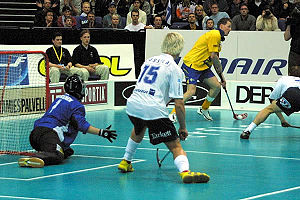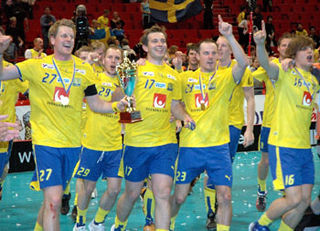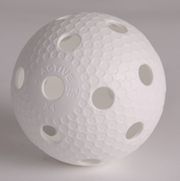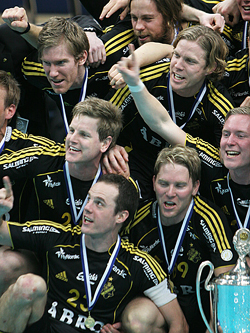Floorball
 A floorball match between Sweden (yellow) and Finland (white). |
|
| Highest governing body | International Floorball Federation |
|---|---|
| Nickname(s) | Innebandy, Salibandy, Unihockey |
| Characteristics | |
| Contact | Minimal |
| Team members | 6 at a time |
| Categorization | Indoor |
Floorball, a type of floor hockey, is an indoor team sport which was developed in the 1970s. It is a fast paced sport, with limited physical contact allowed. Floorball is most popular in areas where the sport has developed the longest, such as the Czech Republic, Finland, Sweden and Switzerland. The game is played indoors on a gym floor, making it a year-round sport at the amateur and professional levels. There are professional leagues, such as Finland's Salibandyliiga and Sweden's Svenska Superligan.
While there are 49 members of the International Floorball Federation (IFF), the Czech Republic, Finland, Sweden and Switzerland have finished in most of the coveted 1st, 2nd and 3rd places at the Floorball World Championships.
In addition to those four countries, floorball is gaining popularity in countries such as Australia, Canada, Japan, Singapore and the United States.
Contents |
History
The game is believed to have originated in Gothenburg, Sweden. The sport began as something that was played for fun as a pastime at schools, and pre-season training for bandy clubs. After a decade or so, floorball began showing up in Scandinavian countries such as Finland, Norway and Sweden, where the once school pastime was becoming a developed sport. Formal rules soon were developed, and clubs began to form. After some time, several countries developed national associations, and the IFF was founded in 1986.
The game of floorball is also known by many other names, such as salibandy (in Finland), innebandy (in Sweden and Norway), and unihockey (in Switzerland and Germany). The names 'salibandy' and 'innebandy' are derived from bandy, a sport that is not at all like hockey with rules similar to those of football (soccer). Both of those names literally translate to 'indoor bandy'. Unihockey is derived from 'univeral hockey' since it is ment to be a special and simplified hockey form.
Expansion
When the IFF was founded in 1986, the sport was played in mostly Scandinavian countries, Japan, and several parts of Europe. By 1990, floorball was recognized in 7 countries, and by the time of the first European Floorball Championships in 1994, that number had risen to 14. That number included the United States, who were the first country outside of Europe and Asia to recognize floorball.[1] By the time of the first men's world championships in 1996, 20 nations played floorball, with 12 of them participating at the tournament.
As of 2009, the sport of floorball has been played in almost 80 countries. Of those, 51 have national floorball associations that are recognized by the IFF. With the addition of Sierra Leone, Africa's first floorball nation, the IFF has at least one national association on each continent of the world, with the exception of Antarctica.
Development
10 years after the IFF was founded, the first world championships were played, with a sold out final of 15,106 people at the Globen in Stockholm, Sweden. In addition to that, the world's two largest floorball leagues, Finland's Salibandyliiga and Sweden's Svenska Superligan were formed, in 1986 and 1995 respectively.
Recognition
In December 2008, the IFF and the sport of floorball received recognition from the International Olympic Committee (IOC). The IFF hopes that this provisional recognition will help allow floorball to become a part of the 2020 Summer Olympics.[2]
In January, 2009, the IFF and the sport of floorball received recognition from Special Olympics. This recognition could make floorball an official Special Olympics sport in just two years. As well, the IFF hopes that floorball will be included as a demonstration sport at the 2013 Special Olympics World Winter Games.[3]
In addition to recognition by the International Olympic Committee and Special Olympics, the IFF is also a member of the General Association of International Sports Federations (GAISF), and co-operates with the International University Sports Federation (FISU).[4]
World championships

The world floorball championships are a semi-annual event where teams from across the world gather to play in a tournament in order to win the world championship. As of 2009, seven men's, as well as six women's, four men's under-19, and three women's under-19 world floorball championships have taken place. The Czech Republic, Finland, Sweden, and Switzerland remain the only four countries to have ever captured a medal at a World Championship event. A floorball world championship is awarded twice a year, and bi-annually in each age group.
- The Men's World Floorball Championships take place every December (since 2008) in every even year.
- The Women's World Floorball Championships take place every December (since 2009) in every odd year.
- The Men's under-19 World Floorball Championships take place every May (since 2009) in every odd year.
- The Women's under-19 World Floorball Championships take place every May (since 2008) in every even year.
From 1996 to 2009, the IFF will use a world floorball championship format where the last team in the A-Division is relegated to the B-Division, while the top team in the B-Division is promoted to the A-Division. This format caused much hardship for countries such as Australia, Canada, Slovakia, and Spain, who have all been trying to get to the B-Division from the C-Division since 2004. In 2010, the IFF plans to adopt a FIFA-like continental qualification system, where teams must qualify to play at the world championships. Depending on the number of countries registered per continent or region, the IFF gives spots for the world championships. For example, Argentina, Brazil, Canada and the United States would need to play for one spot at the world championships in a continental qualification tournament for the Americas.[5]
Gameplay

Measurements
Floorball is played indoors on a rink whose size can officially vary from 18-22 meters wide to 36-44 meters long. The rink is surrounded by 50 cm high enclosed boards with rounded corners. The goals are 160 cm wide and 115 cm high. Their depth is 65 cm and they are 2.85 meters from the end of the nearest boards.
Equipment
Field players
Typical equipment for a floorball player consists of a pair of shorts, a shirt, socks and indoor sport shoes. In addition to that, players are allowed to wear shin guards, eye protectors and protective padding for vital areas. Players, except for the goalkeeper, also carry sticks.
A floorball player is also known as a 'floorballer'.
Sticks
A floorball stick is short compared with ice hockey; the maximum size for a stick is 105 cm. As a stick cannot weigh any more than 350 grams, floorball manufacturers produce sticks that are often made of carbon and composite materials.
Goalkeepers
Goalkeepers wear protection that is very limited; padded pants, a padded chest protector, and a helmet. The goalkeeper can also wear other protective equipment, but bulky padding is not permitted. Some of this other protective equipment includes knee pads, jocks, and gloves.
Ball

In floorball, the objective is to get a plastic whiffle ball into a net with the aid of the stick past a goaltender. A floor ball weighs 23 grams and its diameter is 72 mm. It has 26 holes in it; each of which are 11 mm in diameter. Many of these balls now are made with aerodynamic technology, where the ball has over a thousand small dimples in it that reduce air resistance. There have been several times where a ball has been recorded to have traveled at a speed of approximately 190 km/h.
Rules
Each team can field six players at a time on the court, one player being a goalkeeper. A floorball game is officially played over three periods lasting 20 minutes each. Time is stopped in the case of penalties, goals, time-outs and any situation where the ball is not considered to be in play. An intermission of 10 minutes takes place between each period, where teams change ends and substitution areas. Each team is allowed a timeout of 30 seconds (which is often used late in matches). There are two referees to oversee the game, each with equal authority.
Checking is disallowed in floorball. Controlled shoulder-to-shoulder contact is allowed, but ice hockey-like checking is forbidden. Pushing players without the ball or competing for a loose ball is also disallowed, and many of these infractions lead to two minute penalties. The best comparison in terms of legal physical contact is soccer, where checking is used to improve one's positioning in relation to the ball rather than to remove an opposing player from the play. In addition to checking, players cannot lift another opponents stick or perform any stick infractions in order to get to the ball. As well, players may not raise their stick or play the ball above their knee level, and a stick cannot be placed in between a player's legs (to avoid tripping). The rules of floorball are based on safety of the players.
When a player commits a foul, or when the ball is deemed unplayable, play is resumed from a face-off or a free hit. A free hit involves a player from one team to start play from the place where the ball was last deemed unplayable. A comparison of this is a free kick in soccer. For many fouls, such as stick infractions, a free hit is the only discipline provided. However, at the referee's discretion, a penalty may be worth either two or five minutes. At that point, the player who committed the foul sits in the penalty area, and his team is short handed for the time of the penalty. If an 'extreme' foul is committed, such as physical contact or unsportsmanlike behavior, a player may receive a 10 minute penalty or even a match misconduct.
Forms
Freebandy
Freebandy is a sport that developed in the 2000s from floorball fanatics who specialize in a technique called 'zorro', which involves lifting the ball onto a stick and allowing air resistance and fast movements to keep the ball 'stuck' to the stick. This technique is also referred to as 'airhooking' or 'skyhooking'. In freebandy, the rules are very much the same of those of floorball, with the exception of high nets and no infractions for high sticking. As well, the sticks are slightly tweaked from those of a floorball variety to include a 'pocket' where the ball can be placed.
Special Olympics
Floorball at the Special Olympics is slightly modified from the 'regular' form of floorball. Matches are played 3-on-3 with a goaltender, on a smaller court that measures 20 meters long by 12 meters wide. This form of floorball was developed for the intellectually disabled, and has yet to be played at the Special Olympics. There is a strong possibility that it will be played at the 2013 Special Olympics World Winter Games.[6]
Streetbandy
Streetbandy is a form of floorball that is often played outside. It is usually played on a smaller court, and may involve players playing from 1-on-1 to 5-on-5. Goaltenders do not play in this type of floorball, as the nets are very small (household garbage cans are sometimes used).
Swiss floorball
Swiss floorball is a revised version of a floorball match. The match is played on a slightly smaller court and often involves only three field players playing on each side, in 3-on-3 floorball. This form of floorball is also slightly shorter, with only two periods of 15 to 20 minutes each played.
Wheelchair floorball
Originally developed for players with disabilities, wheelchair floorball is played with the exact same rules as 'regular' floorball. Players use the same stick and ball, and goaltenders are also allowed to play.
The first ever IFF-sanctioned wheelchair floorball matches were played between the men's teams of the Czech Republic and Sweden, during the 2008 Men's World Floorball Championships in Prague, Czech Republic.
In addition to this, there is also an electric wheelchair variation.
Competitions

In addition to the world floorball championships, there are many international floorball club competitions.
Asia Pacific Floorball Championship
The Asia Pacific Floorball Championships are played every single year in Australia, Singapore, or South Korea. The event was created by the Singapore Floorball Association together with the cooperation of the Asia Oceania Floorball Confederation (AOFC). Members of the AOFC get together during this tournament to play for the Asia Pacific Floorball Championship every year. The most recent champions are Singapore.
As of 2010, the Asia Pacific Floorball Championship is also the qualifying tournament for the Floorball World Championships.
Canada Cup
The Canada Cup is an international club tournament that is held every year in Toronto, Canada. It is the largest floorball club tournament outside of Europe, and attracts 40+ clubs from worldwide, every year. The winners of the 2009 tournament were California's X-Stream IB floorball club.
Czech Open
The largest club team tournament, the Czech Open is a traditional summer tournament held in Prague, Czech Republic. It is famous not only for its on-court activities, but also for those off-court. The tournament attracts 200+ clubs every year from 20 different countries. The most recent champions of the prestigious Czech Open are Sweden's IBK Dalen.
EuroFloorball Cup
The EuroFloorball Cup (formerly European Cup) is the only IFF-organized club event. It has taken place every single year since 1993, and in 2000, it changed its format to a 2-year event (i.e. 2000-01). In 2008, the tournament switched back to its one-year format. Teams qualify for the tournament in three different divisions, two of those being East Europe and West Europe, while the other division consists of runners-up to the champions of the top four countries in the previous year's EuroFloorball Cup. The reigning EuroFloorball Cup Champions are SalibanbandySeura Viikingit from Finland.
References
External links
- International Floorball Federation
- Planet Floorball (International floorball resource site)
- Floorball Galaxy.com (International floorball news site)
|
|||||||||||
|
||||||||||||||||||||||||||||||||||||||||||||||||